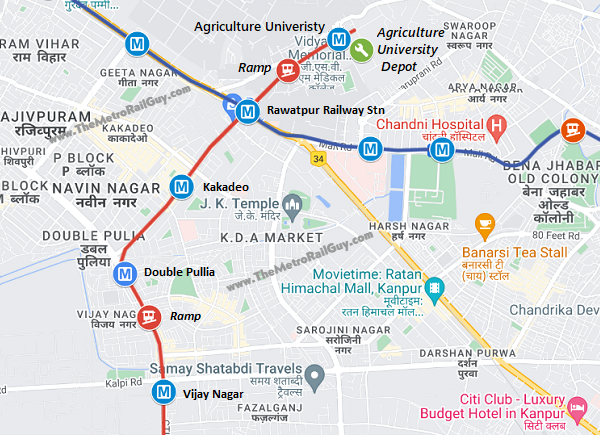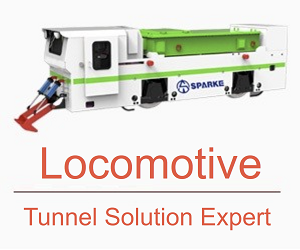KPIL – Gulermak Awarded Kanpur Metro Line 2’s Underground Contract KNPCC-11
Kalpataru Projects International Ltd. (KPIL) – Gulermak JV on Thursday was awarded a Rs. 762.50 crore contract for the underground tunneling & construction work of 8.38 km Kanpur Metro Line-2’s Package KNPCC11.
This approximately 4.08 km section of Line-2 (Agriculture University – Barra-8) will connect Agriculture Depot – Double Pullia Ramp via twin tunnels and 3 underground stations at Rawatpur, Kakadeo and Double Pullia.
KNPCC-11 is the third underground package of the 32.38 km Kanpur Metro Phase 1 project after Line-1’s KNPCC-05 (Chunniganj – Nayaganj) and KNPCC-06 (Nayaganj – Transport Nagar).

Uttar Pradesh Metro Rail Corporation (UPMRC) had invited bids for this contract – the first of two for Line-2 – in February 2023 with a Rs. 1025 crore estimate and 30 month deadline.
Technical bids were opened in July to reveal 9 bidders, and financial bids were opened in October which saw KPIL – Gulermak JV emerging as the lowest bidder – see a list of all firms and their bid values here.
Brief Scope: Design and Construction of TBM Tunnel, Cut and Cover Tunnel, ramp after Double Pullia, ramps in Agriculture Depot for main line and depot connections and three underground metro stations (viz. Rawatpur, Kakadeo and Double Pullia) including Architectural finishes etc. on Corridor-2 of Kanpur MRTS Project at Kanpur, Uttar Pradesh, India india

This contract will be financed by the European Investment Bank (EIB) through a €650 million (approx. Rs. 5661 crore) loan approved in July 2020.
This is the 1st of 2 civil packages of the city’s Line-2. The other package (KNPCC-12) consists of 2 disjointed elevated sections with 5 stations at Agriculture University Station, Vijay Nagar Chauraha Station, Shastri Chowk Station, Barra-7 Station & Barra-8. Bids for its construction were invited in November and the current technical bid opening date is January 9, 2024.
Coming back to KNPCC-11, with the contract now squared away – I expect basic groundwork (pre-construction activities) to start in Q1 2024, actual construction work in early Q2 2024, and tunneling works in mid 2025.
Like Phase 1’s other 2 underground sections on Line-1 (KNPCC-05 & KNPCC-06), UPMRC likely requires KPIL – Gulermak JV to use at least 2 tunnel boring machines (TBMs) for constructing 6 tunnels.
With Gulermak winning this, there’s a good possibility that we might see them re-using their Terratec machines TBM Tatya (S92) and TBM Nana (S93) from Package KNPCC-05 (Permat Ramp – Nayaganj) where they each have just one final tunneling assignment left. Whether that happens or not, we should find that out by the middle of 2024!
For more updates, check out the Kanpur section or my Home Page! Sign up for free instant email notifications on new posts over here. Like this post? Get early-access to updates and support the site over here.
– TMRG




Lucknow is waiting for its line 2. Good that Kanpur is getting it. Deserves more investments.
So both lines will become operational in 2026 ig?
No, it’s already 2024
Tunneling can not start for atheist next 8-10 months even if everything goes super quick. And then each TBM has to dig 4 km+ (considering they use 2 tbm) and include the time it takes to relaunch a tbm after a breakthrough. You already already deep in 2026 by now and we still have to work on stations, track, signalling, electrification, testing, inspections and so on. So no sooner than 2027 end (extremly optimistic timeline) or even 2028. These things take time.
It seems to be total tunnel length, each mc only 2km.
Pushpendra Singh
We are a specialist contractor designing, supplying and installing high performance 4-hour fire and blast protection systems. We have worked on metro and rail projects all around the world, including London Underground/Crossrail (UK), Dubai Metro (UAE), Doha Metro (Qatar), KL MRT (Malaysia), Kolkata Metro (India) and are currently executing works on both Riyadh Metro (Saudi Arabia) and Mumbai Metro (India). We supply a range of systems that are a much lighter and slimmer, fire-rated alternative to traditional concrete constructions, and all fully internationally certified to the required standards. Our typical applications include:
OTE (Over Track Exhaust) Smoke Extract Ducts & Grilles
Plenum Ventilation Ceilings (connections to TVS shafts)
Demountable Panels/Barriers (TPS/Battery Rooms to allow for transformer maintenance access)
Cross Passage Barriers & Doors
Equipment Delivery Hatches (up to 5m x 4m)
Access Hatches & Floor/Pit Covers
Please connect for any such requirements.